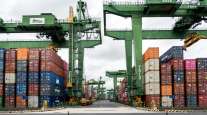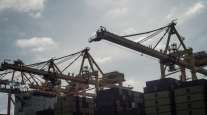Trade Gap Grew in May as Exports Fell Most in Three Months

The U.S. trade deficit widened in May as exports declined by the most in three months, showing businesses were having trouble drumming up sales to overseas customers.
The gap grew 2.9% to $41.9 billion from the prior month’s revised $40.7 billion, Commerce Department figures showed July 7 in Washington. The median forecast in a Bloomberg News survey of economists called for a $42.7 billion shortfall. Exports dropped 0.8% on declining demand for commercial aircraft and industrial equipment.
Domestic crude production further reduced America’s imported fuel bill, which dropped in May to the lowest level since February 2002. While persistent U.S. household spending led to record automobile imports, unsettled European and Chinese economies are limiting prospects for a pickup in exports.
“We have weaker growth abroad, and we’re looking at the lagged effects of a stronger dollar restraining exports as well,” Jay Bryson, global economist at Wells Fargo Securities in Charlotte, North Carolina, said before the report. “With domestic demand in the United States remaining pretty solid, that pulls in imports at a faster rate than exports.”
Bloomberg survey estimates from 69 economists ranged from deficits of $38.5 billion to $47.4 billion. The Commerce Department initially reported a $40.9 billion shortfall for April.
Exports declined to $188.6 billion from $190.1 billion in April. Shipments overseas were also depressed by less demand for telecommunications equipment, pharmaceuticals and semiconductors.
The decrease in exports was limited by a pickup in U.S. sales of oil products and chemicals. Excluding petroleum, the deficit widened 6.5% in May.
Imports were little changed at $230.5 billion in May from $230.8 billion in the prior month as American companies bought less crude oil, chemicals and capital goods, including drilling equipment.
Auto imports jumped $847 million in May to a record and demand for most consumer goods also picked up, underscoring a rebound in household spending.
After eliminating the influence of prices, which generates the numbers used to calculate gross domestic product, the trade deficit widened to $58.4 billion compared with $56.9 billion a month earlier.
The swelling gap between exports and imports depressed the economy in the first quarter, according to Commerce Department figures. The deficit subtracted 1.9 percentage points from growth in the world’s largest economy, the most since 1985.
A slower global economy and a strong dollar represent hurdles for U.S. growth. The dollar’s advance since June 2014 has made U.S. goods and services more expensive for overseas customers.
Greece’s possible exit from the euro risks destabilizing the broader European economy. The country’s voters emphatically endorsed Prime Minister Alexis Tsipras’s call for a “no” to more austerity in a referendum. Now buckling under the strain of capital controls, the Greek economy has already shrunk about 25% over the past six years while the jobless rate there is still the highest in the euro region.
In China, the Shanghai Composite Index had fallen 27% through July 3 from its peak in mid-June, forcing policymakers to address how to promote economic stability while liberalizing the $10 trillion economy. Bloomberg’s monthly GDP tracker shows the economy has been below the government’s targeted pace of about 7% all year.
Strong payroll growth and a pickup in housing industry momentum are boosting prospects for steady demand from U.S. consumers, buoying the import side of the trade ledger. The brightening outlook has Federal Reserve policymakers considering an increase this year in the benchmark interest rate for the first time since 2006.
“Most participants are anticipating that a rate increase this year will be appropriate,” Fed Chair Janet Yellen said in a June 17 press conference. “That assumes, as you can see, that they’re expecting a pickup in growth in the second half of this year and further improvement in labor market conditions.”




